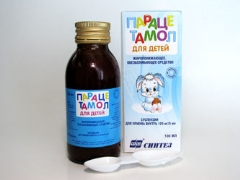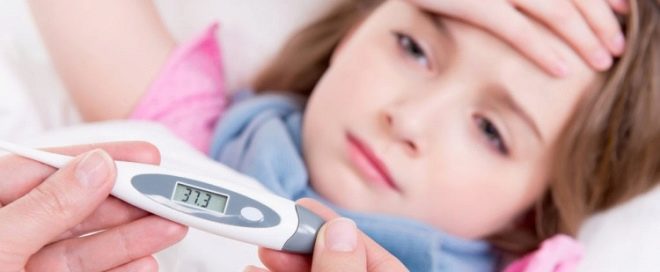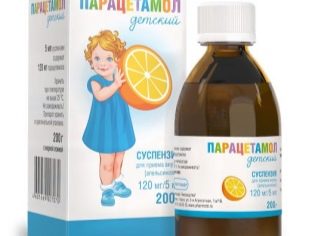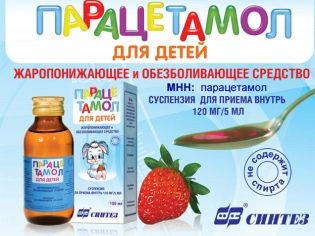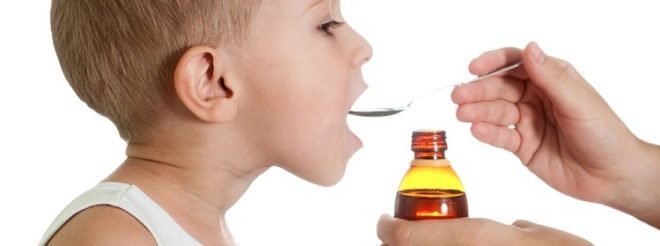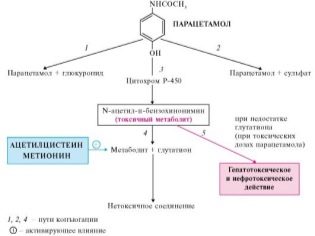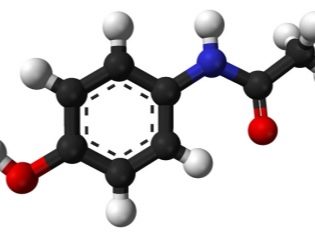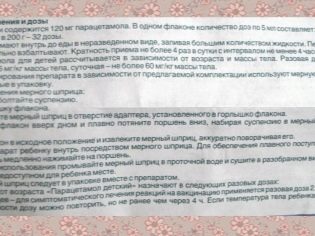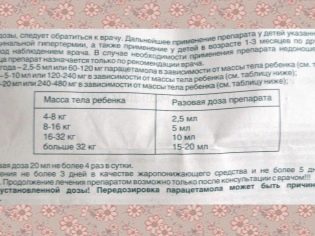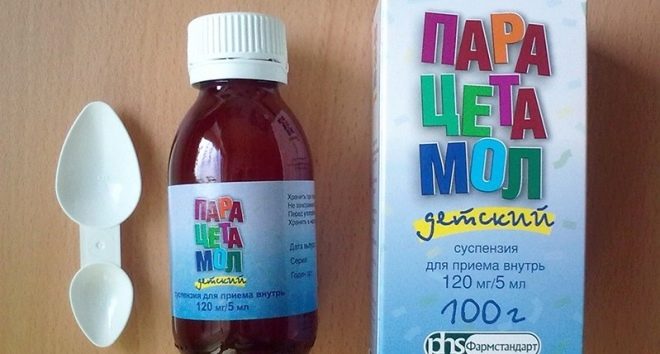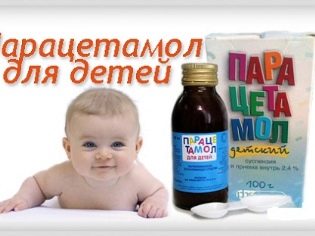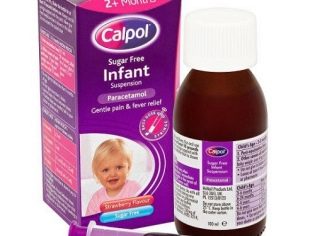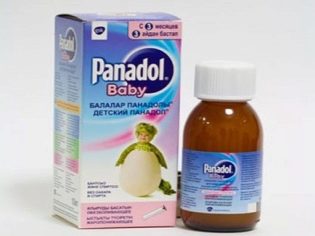Suspension "Paracetamol children": instructions for use
Paracetamol, according to many pediatricians and mothers, is the safest antipyretic agent in childhood. If you want to give a medicine on the temperature of a child under one year old, doctors usually choose him. And since fever occurs in children quite often, this drug should be kept at home for emergency cases.
One of the most popular forms of paracetamol is suspension. At what age is it allowed to give it to children, at what dose is it administered, and how long is the medication allowed? Is it possible to give a suspension to the baby, what negative effects can it provoke and what drugs with a similar effect can be replaced? You will find answers to these questions in this article.
The form of release of the drug and its composition
Paracetamol in suspension is produced by pharmaceutical companies:
- Pharmstandard-Leksredstva (this drug is called "Paracetamol for children");
- Synthesis (on the packaging of this drug writes "Paracetamol for children").
This medication is a homogeneous thin liquid, which has a gray or gray-yellow color. To make the suspension easier for children to swallow, the medicine was made sweet to the taste, it smells like orange or strawberry.
The suspension is placed in glass bottles, which are sold with a syringe with a graduation or a plastic spoon. One bottle can contain 100, 150 or 200 grams of the drug, which corresponds to 16, 24 or 32 doses of the drug.
A single dose is considered 5 ml suspension. From this amount of liquid, the patient receives 120 mg of paracetamol, and the excipients in this medicine are sucrose, sorbitol, xanthan gum, propylene glycol and other compounds.
Mechanism of action
Paracetamol affects enzymes called cyclooxygenases, which are found in brain cells. The result of blocking such enzymes will be the impact on the centers that regulate body temperature and are responsible for pain.
At the same time, the drug does not affect cyclooxygenase in peripheral tissues (this is prevented by the appearance of cellular peroxidases at the site of inflammation), therefore Paracetamol's anti-inflammatory effect is very low. However, due to such a mechanism, the preparation also does not affect the mucous membrane of the digestive tract and the exchange of sodium and water.
After ingestion, the ingredients of the suspension are absorbed fairly quickly and reach a maximum concentration in the blood after 0.5-2 hours.
If we talk about antipyretic or analgesic effect, then this form of Paracetamol begins to act in 15-30 minutes.
Next, the active substance enters the liver and is converted into metabolites, which are excreted from the child’s body by the kidneys. If a child has diseases of these organs, paracetamol metabolism is disturbed, which may increase the risk of its side effects.
Indications
The most common reason for using a suspension is an increased body temperature. The drug is prescribed for influenza, measles, scarlet fever, mumps, chicken pox, SARS and other infections caused by both viruses and harmful bacteria.
Medication helps eliminate fever with bronchitis, sore throat, otitis and other diseases, but in such cases, it is always prescribed together with other treatments that affect the cause (antibacterial agents).
Reception of Paracetamol is also recommended for children who have an increased body temperature after vaccination. Since the suspension also has an analgesic effect, such a tool can be taken:
- with toothache, including pain when teething baby teeth;
- with headache, if it is moderate or weak;
- with sore throat, for example, caused by tonsillitis;
- for ear pain caused by otitis media;
- for pain caused by bruise, sprain, or other trauma.
At what age is children prescribed?
Paracetamol in suspension should not be given to newborns. Infants aged one to three months such a drug is prescribed in a limited way:
- it can be given only as prescribed by a doctor;
- the most common cause of admission is post-vaccination temperature rise;
- means give once in a dosage which the pediatrician counts.
If the temperature has risen in a child over 3 months old, the suspension can be given safely. but pediatric examination is desirableIndeed, Paracetamol is only a symptomatic remedy, and in many cases the administration of a suspension alone will not be enough.
If a child is 6 years old, liquid Paracetamol can already be replaced with a solid form, but some patients older than six years are more comfortable to continue giving the suspension, because it is easier to swallow it.
Typically, this form of medication is prescribed until the age of twelve, since adolescents require a higher dosage, and it is inconvenient to take a large amount of sweet syrup at a time.
When is it prescribed for fever?
The rise in body temperature is, first of all, a kind of protection of the child's body from infectious agents, thanks to which the body fights against the disease. For this reason, giving the child Paracetamol with a slight increase in temperature is not worth it.
According to doctors, antipyretic no medicines are needed if the child suffers fever normally. In most babies, the condition worsens as the thermometer increases to + 38.5 + 39. It is at this temperature that the use of Paracetamol in suspension will be justified.
But there are situations when the medicine should be given at lower numbers, for example, if your child once had febrile seizures during a fever or has a neurological pathology in which the risk of seizures is increased. In addition, some children find it difficult to endure even a small rise in temperature. In this case, the suspension can be given earlier, and not to wait when the numbers on the thermometer exceed 39 degrees.
Note also that Paracetamol should be given at any indicator of the thermometer, if the fever is caused by overheating or vaccination. In these situations, the temperature reaction does not act as a defense, therefore, it is not necessary to delay in taking the suspension.
Contraindications
Suspension is not prescribed if the child has hypersensitivity to both paracetamol and any auxiliary ingredient. In addition, this drug should not be given:
- with erosive changes in the wall of the digestive tract or gastrointestinal ulcer;
- with bleeding that starts from the wall of the stomach or intestines;
- with deficiency of enzymes called “glucose 6 phosphate dehydrogenase” and “isomaltase”;
- with fructose intolerance;
- with glucose-galactose malabsorption.
In addition, there are many diseases in which the suspension is allowed only under the supervision of a physician. First of all, these are diseases of the kidneys, blood and liver, as well as bronchial asthma and allergies. Therefore, the use of Paracetamol in a child with any disease is permissible only as prescribed by the doctor.
Side effects
As a result of taking the suspension, a child may develop:
- Allergic reaction.Most often it is a rash or itching of the skin, but sometimes the manifestations of allergies can be dangerous, for example, when paracetamol provoked angioedema or urticaria. If any of the symptoms of allergy appeared after taking one or more doses of the medicine, Paracetamol should immediately be canceled, and the child should be shown to a doctor.
- In rare cases, treatment has a negative effect on the number of blood cells (the drug affects their formation), which is manifested by anemia or a decrease in the level of platelets in the general blood test. This negative effect is typical for long-term use of the suspension, so the drug has limitations on the duration of use.
- If a child has previously developed intolerance to other NSAIDs (for example, acetylsalicylic acid), after taking Paracetamol, the patient may develop a bronchospasm.
- Very rarely, the drug adversely affects the liver (this can be seen in terms of biochemical analysis). In addition, the digestive system of some babies reacts to the suspension by the appearance of nausea, loose stools and other unpleasant symptoms.
Instructions for use
How to give the drug?
Before giving the medicine to the child for the first time, shake the bottle so that all the ingredients are evenly mixed. Stirring is also necessary with each subsequent use, as paracetamol and other components settle in the water, and without stirring the child can receive the medication in the wrong dose.
Dilution of the suspension with water is not required because it will increase the volume of the medicine and it will be difficult for some children to swallow it. It is best to have the baby drink Paracetamol in undiluted form, and then drink it with water in a volume of at least 100 ml. Medication is recommended. before meals or after 1-2 hours after the child has eaten.
For dosing suspension, a measuring syringe is used. When a child swallows the drug, rinse the syringe with water and allow it to dry, then put it in the box.
If instead of a syringe in a package there is a plastic spoon, then one side can take 2.5 ml of the suspension, and the second - 5 ml. Having given the medicine from a spoon, it must also be washed and left to dry, and then put in a box to the bottle.
Dosage
For a particular child, the doctor usually calculates the required single dose by weight. For this body weight in kilograms multiplied by 10-15. The resulting number will be the number of milligrams of paracetamol, which must be given to the baby at one time.
For example, the medication is required to give a child whose weight is 12 kg. Multiplying 12 by 10, we get a single dose of 120 mg, which corresponds to 5 ml of suspension.
In the same way, and calculate the maximum dose per day. To determine how much medicine will be maximum permissible for a child, you need to multiply its weight in kilograms by 60. For example, for the same child weighing 12 kg, the suspension dosage per day should not exceed 720 mg (12x60). This amount of paracetamol is contained in 30 ml of suspension, that is, with a fourfold intake, the baby should not receive more than 7.5 ml of this medicine.
If you look at the annotation, which is attached to the bottle, you can see approximate dose table. In one of its columns, the child’s weight is noted, but on the contrary, the dose of medication that can be given at that body weight is indicated. For a child from our example, you need to find the value "8-16 kg", and in front of him you will see "5 ml" (single dosage of the drug).
How often can I give?
It is possible to give a suspension both once a day and more often, but the frequency of taking such a medicine should not exceed 4 times. In addition, the break between taking the medication should be long - the next dose can be given no earlier than four hours after the previous one.
If after taking the temperature does not go astray, best to consult a doctorespecially if the child is not yet one year old.
How long can you take?
As mentioned above, there are limitations for the duration of Paracetamol intake:
- if the medication is prescribed as an antipyretic medication, it can be given up to 3 days;
- if the drug is given to a child in order to eliminate or reduce pain, then a longer reception is acceptable - up to 5 days.
If the patient takes Paracetamol for pain for 5 days, and for fever for 3 days, but these symptoms still bother you, you cannot continue to give the suspension without the permission of the doctor who supervises the child. Longer admission must be monitored by a pediatrician, as it requires additional laboratory tests.
Overdose
If the child is accidentally given a suspension in excess dosage, it will cause diarrhea, abdominal cramps, vomiting and other negative signs of the digestive system.
When you take a significant dose of medicine can affect the liver, but this reaction does not develop immediately, so the child with an overdose must be examined by a doctor, even if his health is not disturbed.
Interaction with other drugs
Do not give the baby at the same time Paracetamol in suspension and any other medicines that contain paracetamol, as this may lead to an excess dose. It is also not recommended to use the suspension together with other antipyretic or analgesic agents, for example, with Ibuprofen or analgin. The alternation or combination of such drugs is possible only as prescribed by a physician.
Annotation to the suspension includes a list of other medicines, the use of which together with Paracetamol is prohibited or not recommended. If the child is already taking any medications, you should make sure that they are not in this list.
Terms of sale
Liquid Paracetamol, like other forms of this medicine, can be freely purchased at a pharmacy without a prescription. The price of the drug affects both the manufacturer and the volume of the bottle. On average, for 200 g of suspension you need to pay 110-120 rubles.
Storage features
Paracetamol shelf life is 3 years and does not decrease after opening the bottle. Both a sealed and an open bottle can be kept at room temperature (no need to put medicine in the fridge).
For storage it is recommended to choose a place in which the drug will be hidden from children, because the risk of overdose increases due to the pleasant smell and taste with easy access.
Reviews
Most reviews of Paracetamol in suspension are positive. First of all, they note its high efficiency and safety for children.
According to moms, he quickly knocks the temperature, and the pain decreases or disappears altogether. This form of Paracetamol is chosen more often because it is easy to dose, and the taste of the drug is sweet, so most young patients swallow the suspension without any difficulty.
However, there are negative reviews that complain about the composition of the drug, because it contains chemical additives that can provoke allergies. To reduce the risk of an allergic reaction (if it is quite high), mothers have to replace the suspension with candles.
As for the cost, then it is called affordable, therefore, liquid Paracetamol is more in demand than its counterparts. The tolerability of the drug, judging by the majority of reviews, is mostly good. Only in rare cases, the suspension has provoked nausea, skin rash or other negative reaction.
What to replace?
If Paracetamol was not in the pharmacy, another liquid paracetamol-based medicament will be suitable for replacing this drug:
- Calpol In one bottle of this medicine is 70 or 100 ml of strawberry pink suspension. Attached to the bottle spoon, which can measure 2.5 and 5 ml of liquid.
- Efferalgan. This drug is represented by yellow-brown syrup, which has a caramel-vanilla flavor.Its volume in one vial is 90 ml, and the manufacturer offers to measure the medicine with a measuring spoon.
- Children's Panadol. Such pink strawberry medicine is produced in bottles of 100 and 300 ml, to which a measuring syringe is applied.
All these drugs can be given to children. older than 3 months, the amount of paracetamol in them is 120 mg in 5 ml, and the indications, possible side effects, contraindications and other nuances of use for such agents are the same.
If paracetamol preparations cannot be given to a baby (for example, a child has intolerance), they are often replaced with ibuprofen-based medicines, since such antipyretic drugs are also considered safe for children. The child can be given a suspension Nurofen, Ibuprofen, Ibuprofen-Akrihin.
Such medicines effectively fight fever and pain, and their therapeutic effect lasts longer than that of Paracetamol. Any of these suspensions can be applied from 3 months of age with a baby weight greater than 5 kilograms.
Since not only analgesic and antipyretic effects are noted in ibuprofen preparations, but also an anti-inflammatory effect, such analogs will be most preferable, if the child has a pronounced inflammatory processFor example, with otitis or sore throat.
